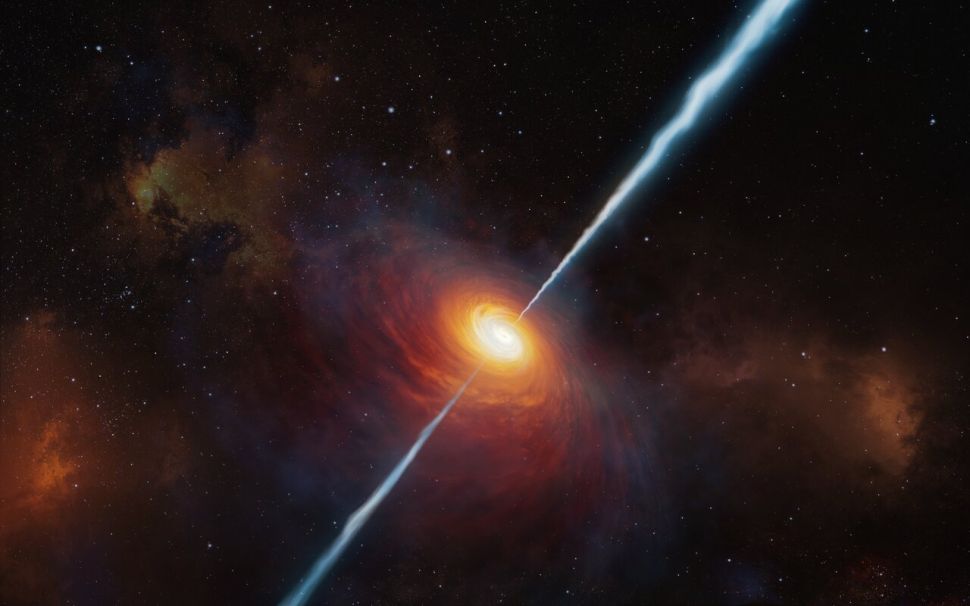Scientists find most distant quasar shooting powerful radio jets

A newly discovered quasar from the early universe is the most distant found to date that’s shooting out powerful radio jets.
Astronomers using the European Southern Observatory’s (ESO) Very Large Telescope (VLT) recently discovered the quasar, called P172+18, which is so far away that it takes about 13 billion years for the light from this quasar to reach Earth, where we observe the object as it was when the universe was just 780 million years old. While the new find is not the most distant quasar ever detected, it appears to be the most distant radio-loud quasar, or radio jet-emitting quasar.
Quasars are extremely bright celestial objects powered by supermassive black holes that lie in the center of some galaxies; sometimes quasars are so bright that they eclipse the very galaxies containing them. Radio-loud quasars shoot out powerful jets that are strong sources of radio-wavelength emissions. This quasar was first identified as a radio source when scientists using the Magellan Telescope at Las Campanas Observatory in Chile detected these powerful jets.
“As soon as we got the data, we inspected it by eye, and we knew immediately that we had discovered the most distant radio-loud quasar known so far,” Eduardo Bañados of the Max Planck Institute for Astronomy in Germany, who led this discovery alongside ESO astronomer Chiara Mazzucchelli, said in a statement.
The distant, jet-shooting quasar is powered by a supermassive black hole that’s about 300 million times more massive than our sun and is growing quickly, pulling in and swallowing surrounding matter with its gravity.
“The black hole is eating up matter very rapidly, growing in mass at one of the highest rates ever observed,” Mazzucchelli said in the same statement.
The researchers think that there could be a connection between the quick growth of black holes like this and the jets that shoot out of radio-loud quasars like P172+18, according to the statement. In particular, the astronomers think that these powerful jets might interact with nearby gases in a way that pushes the gases into the gravitational grip of these black holes, increasing how much gas falls into them.
So, as they uncover more details about this quasar, scientists will also continue to learn about the supermassive black hole accompanying it far out in the universe.
“I find it very exciting to discover ‘new’ black holes for the first time, and to provide one more building block to understand the primordial Universe, where we come from, and ultimately ourselves,” Mazzucchelli said.
In addition to the VLT and the Magellan Telescope, which helped scientists to originally identify the radio signal that they now knows is a quasar, the team also used facilities including the National Radio Astronomy Observatory’s (NRAO) Very Large Array (VLA) in New Mexico and the Keck Telescope in Hawaii.
This work was described in a paper published March 8 in The Astrophysical Journal.


„Lorem modi tempora incidunt ut labore et dolore magnam.”
– Marcus Pervetti
Vivamus in diam turpis. In condimentum maximus tristique. Maecenas non laoreet odio. Fusce lobortis porttitor purus, vel vestibulum libero pharetra vel. Pellentesque lorem augue, fermentum nec nibh et, fringilla sollicitudin orci. Integer pharetra magna non ante blandit lobortis. Sed mollis consequat eleifend. Aliquam consectetur orci eget dictum tristique.
Aenean et sodales est, ut vestibulum lorem. Ut ultricies imperdiet sodales. Aliquam fringilla aliquam ex sit amet elementum. Proin bibendum sollicitudin feugiat. Curabitur ut egestas justo, vitae molestie ante. Integer magna purus, commodo in diam nec, pretium auctor sapien. In pulvinar, ipsum eu dignissim facilisis, massa justo varius purus, non dictum elit nibh ut massa. Nam massa erat, aliquet a rutrum eu, sagittis ac nibh.
Lorem ipsum dolor sit amet
Class aptent taciti sociosqu ad litora torquent per conubia nostra, per inceptos himenaeos. Orci varius natoque penatibus et magnis dis parturient montes, nascetur ridiculu.Curabitur sed iaculis dolor, non congue ligula. Maecenas imperdiet ante eget hendrerit posuere. Nunc urna libero, congue porta nibh a, semper feugiat sem.
Duis dignissim mi ut laoreet mollis. Nunc id tellus finibus, eleifend mi vel, maximus justo. Maecenas mi tortor, pellentesque a aliquam ut, fringilla eleifend lectus. Maecenas ultrices tellus sit amet sem placerat tempor. Maecenas eget arcu venenatis, sagittis felis sit amet, dictum nisl. Orci varius natoque penatibus et magnis dis parturient montes, nascetur ridiculus mus. Phasellus vitae vulputate elit. Fusce interdum justo quis libero ultricies laoreet.
Loem ipsum dolor
Praesent nec magna ac pede. Mauris suscipit mauris. Nam quis erat id tortor.
Loem ipsum dolor
Praesent nec magna ac pede. Mauris suscipit mauris. Nam quis erat id tortor.Anim ad minim veni sit amet qua ipsum dolor.
Quantum vertrori quanta
